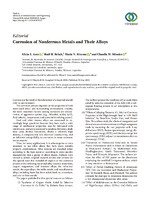| dc.identifier.citation | Arias, A. E., Rebak, R. B., Biezma, M. V., y Méndez, C. M. (2018). Corrosion of nonferrous metals and their alloys. Egipto: Hindawi. 2 p. | es_AR |
| dc.description.abstract | Corrosion is the result of the interaction of a material (metal) with its environment.
Thecorrosion process depends on the properties of both metal (and alloy) and surrounding environment. Usually, the more important factors causing corrosion are concentration of aggressive species (e.g., chloride), acidity (pH), fluid velocity, temperature, and potential (oxidizing power).
Steel and other ferrous alloys are consumed in ex ceedingly large quantities because they have such a wide range of mechanical properties, may be fabricated with relative ease, and are economical to produce. However, steels have some distinct limitations, chiefly a relatively high density, a comparatively low electrical conductivity, and an inherent susceptibility to corrosion in some common environments.
Thes, for many applications, it is advantageous or even necessary to use other alloys that have more suitable property combinations. Alloy systems are classified either according to the base metal or according to some specifi characteristic that a group of alloys shares. Authors were invited to submit original research articles and reviews for this special issue that included all aspects of the corrosión process of the following metal and alloy systems: aluminum, copper, magnesium, and titanium alloys; the refractory metals; the superalloys; the noble metals; and miscellaneous alloys, including those that have nickel, lead, tin, zirconium, and zinc as base metals.
The papers published in this special issue are as follows:
(i) “Synthesis of Copper Oxide Aided by Selective Corrosion in Cu Foils,” by Roberto Baca Arroyo.
The authors present the synthesis of Cu oxide film aided by selective corrosion of Cu foils with a sub sequent heating process in air atmosphere at low temperaturas.
(ii) “Effects of Alloying Elements (Cr, Mn) on Corrosion Properties of the High-Strength Steel in 3.5% NaCl Solution,” by BomiKim, Soojin Kim, and Heesan Kim. %e authors study the effects of manganese and chromium on corrosion resistance of high manganese steels by examining the rust properties with X-ray diffraction (XRD), Raman spectroscopy, energy dispersive spectroscopy (EDS), and electron energy los spectroscopy (EELS) adjunct to transmission electronmicroscopy (TEM).
(iii) “Transition of Dislocation Structures in Severe Plastic Deformation and Its Effect on Dissolution in Dislocation Etchant,” by Muhammad Rifai, EbadBagherpour, Genki Yamamoto, Motohiro Yuasa, and Hiroyuki Miyamoto. %e authors an Alyse the effect of SSE passes on the dissolution employing the modified Livingston etchant, which is very sensitive to dislocations.
(iv) “Effect of Partial Cladding Pattern of Aluminum 7075 T651 on Corrosion and Mechanical Properties,” by Rendell, Hsiao, and Shirokoff. %e authors estimate the clad spot to determine dimensions for a two-dimensional aluminum alloy array.
(v) “Effect of Molybdenum on the Corrosion Behavior of High-Entropy Alloys (HEAs) CoCrFeNi2 and CoCrFeNi2Mo0.25 under Sodium Chloride Aqueous Conditions,” by Alvaro Rodriguez, Joseph Tylczak, Michael Gao, Paul D. Jablonski, Martin Detrois, Margaret Ziomek-Moroz, and Jeffrey Hawk. The authors investigate the corrosion behavior of high entropy alloys (HEAs) CoCrFeNi2 and CoCrFe-Ni2Mo0.25 in 3.5 wt. percent sodium chloride (NaCl) at 25°C by electrochemical methods. | es_AR |



